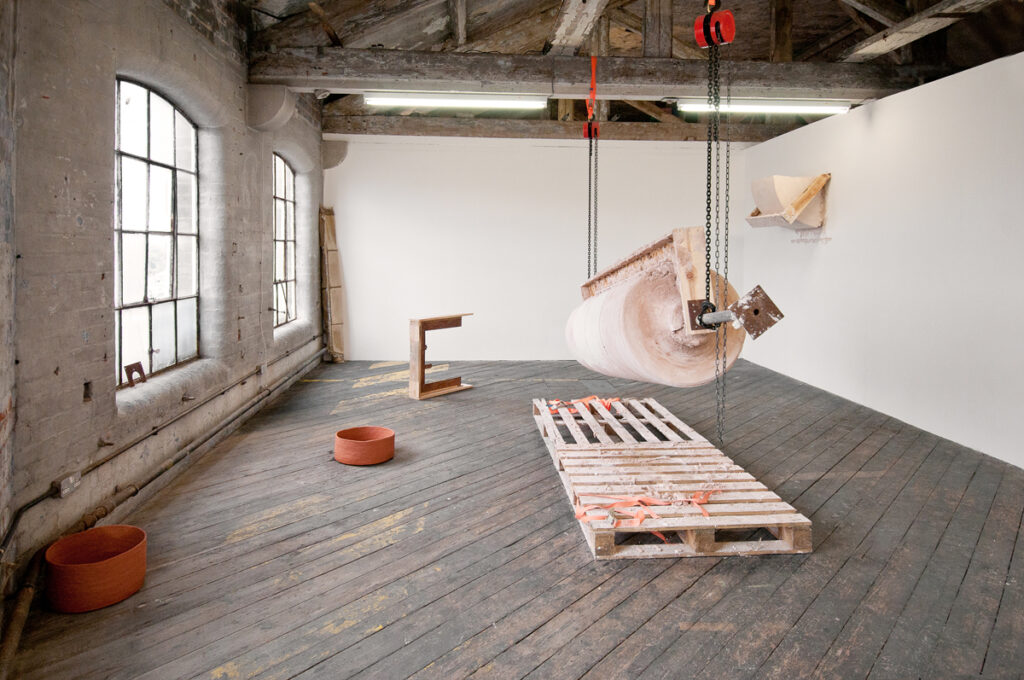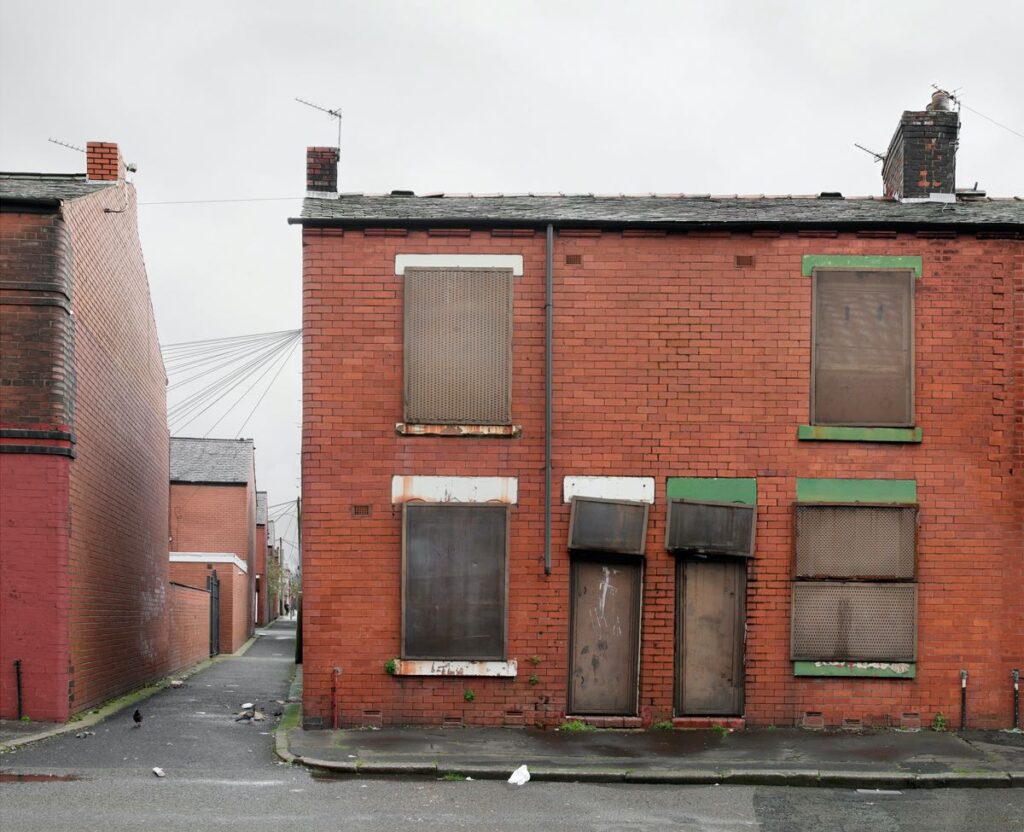Katharina Fitz whose work comprises of sculpture and installation often in reference to architecture and industrial process. She questions the hierarchy and value of objects and their relationship to the viewer and the space. She completed her MFA at Nottingham Trent University in 2019 and has since been selected for Bloomberg New Contemporaries 2019 and the One Thoresby Street Production Award. In 2020 she was awarded the Gilbert Bayes Sculpture Award organised by the Royal Society of Sculptors and selected for London Bronze New Editions. Born in Austria, she has lived and worked in Nottingham since 2016.
Find out more about Katharina’s work on her website and follow her on Instagram.
Where are you based?
I’ve been based in Nottingham since 2016.

Describe your practice for us
Today, I observe a disconnection between the artist’s studio and the gallery space. Within my installations, I import studio arrangements and objects of process into the exhibition space to bring the intimacy of the making to the audience.
There is an emphasis on process and materials where my body becomes a tool assisting the objects to come to life. Usually, moulds and jigs are seen as unappreciated by-products and discarded from the viewer, whereas in my work I present them as objects in their own right. This raises questions about the commercial expectation and value of the finished object in a consumerist society.
Through the use of different techniques, I constantly flip, copy, turn, mirror, and mutate objects. This enables me to push form into abstraction giving rise to something new and unknown.
The interaction between the sculptures and their environment is important. Sometimes the work functions as a sort of prosthesis, other times objects of space are decontextualised. A translation from architectural into sculptural space takes place. With my work I prompts the viewer to rethink the making of objects, the behaviour of the space and how it could be animated, changed, or extended into a new kind of imagined and activated environment.
How long have you been practising and by what route did you come to your practice?
I completed my BA in photography and film at the Sant Ingasi Institute in Barcelona in 2008 and started working on my first photo projects in 2013. In 2016 I moved to the UK and decided to study an MFA at Nottingham Trent University. Since then I have been mainly engaging with sculpture.

Tell us more about the notion of your work as a form of language
There are different ways of communicating language through sculpture. There are different traits that evoke a specific aura of a work within a space. In my project, ‘BLOOM’ for example the overall feel of the work was calm, precise and at times fragile and carefully balanced, whereas in my last project ‘When Seams Become Audible’ the tone was rougher, corrupted and grungy.
Language and translation also appear in the way I work with objects in the studio. I think of objects as being in a constant flow of change and through the use of different techniques, I create a vocabulary of process of my own. I understand the various stages and mutations that come with it as words within a grammatical structure of a sentence, which I layout from the viewer to dissect.
What is it about bringing the ‘intimacy of the process of making into the experience of the viewer’ that is important to you?
I am interested in showing objects of process and importing studio arrangements into the gallery space to engage the viewer with the making of the sculptures and maybe also opening up their imagination to how objects that surround us in our daily lives are made. I have a fascination for making, and I want to share this excitement with the audience, by partially letting them into my studio space without giving too much away.
Exhibiting the process also is a way of questioning the relationship that we have with the overly commercialised object in the art world breaking with the idea of the finished object and emphasising the process rather than the end result.

Recently you had a solo show at One Thoresby Street in Nottingham. What was your decision behind breaking down the centre piece of the exhibition in front of a virtual live audience?
I suppose this question raises many questions that come with it. There is no fixed answer to it, as I am still trying to figure it out for myself at the moment. Breaking down the centre piece resulted in being quite emotional for me, as I create a strong relationship with my work through the physical engagement I build with it along the way. I think that there is a beauty and preciousness about being able to experience the work only within the specific time frame of the exhibition and within its specific environment. I ask myself how this work would function outside of its context of the exhibition for which it was made.
The question of storage is another important factor. How do we approach the production of a work of art and how and where can it survive? What is the nature of the space and how do we move work within these limited boundaries? And then the question of documentation versus performatively. There seems to be a fine line between the two and by filming the de(con)struction I might have entered new territories within my practice.

What connection, if any, is there between your sculptural and photographic work?
Within my photo projects I have an interest in the structures that we find within cities and how they affect our coexistence within urban space. My photographs have a strong emphasis on architecture but always looking at spaces from the outside, at a distance, presenting their facades. My sculptures feel very architectural too, but it feels as if I have zoomed into the spaces we inhabit. The interior, the details, the materiality and the infrastructure present have turned into my source material from which I take, but in a more abstracted way. Both speak an urban language and expose the human condition within these structures.

What is important to you in maintaining and motivating your practice?
The motivation most of the times comes from inside. I would say that I go through different phases of reading, making and resting. Community and exchange are important too. I want to bring a group of practitioners together to meet once a month to discuss our work. I think that exchange is something vital for the understanding of one’s own and others’ practice and having a support net is crucial too.
Finding the right studio for my practice was a very important factor to maintain my practice. I found an active space where I feel welcome and can be part of a community. Also, I have started collaborating with the writer and artist Sarah Tutt which is something that excites and motivates me too.
What have been your biggest achievements since establishing your practice?
After graduating from my MFA at Nottingham Trent University I was awarded the One Thoresby Street Production Award as part of the New Art Exchange Open which lead to my first solo show. I also was selected for Bloomberg New Contemporaries in 2019, the Gilbert Bayes Award for early career sculptors in 2020 and I am currently working with London Bronze on a bronze edition of one of my works, which I am very happy about.

What have been the biggest challenges to your practice?
The biggest challenge so far has been finding an adequate and affordable studio in Nottingham. After graduating I had to stop making during almost one year which resulted very difficult for me.
What is the most interesting or inspiring thing you’ve seen or attended recently, and why?
Mona Hatoum’s work ‘Remains of the Day’ was a very inspiring show I saw last year. She burns and charrs in chicken wire wrapped furniture and domestic objects and places these precarious objects carefully arranged in the gallery space. The black and brittle forms reflected something dark and threatening. I was very drawn to the emotive language, process as well as the materiality of the work.

Which other artists’ work do you admire, and why?
Just to name a few:
- Rachel Whiteread. Translation from architectural into sculptural space.
- June Crespo. The rough language of her sculptures and her engagement with materiality and process
- Gabriel Orozco: Strong concepts, playful approach
- Holly Hendry: Structure, color, experimental architecture
- Emma Cocker: very inspiring reading. Ex. ‘The Yes of the No’, ‘Tactics for Not Knowing’
Who would you most like to have visit your studio?
No specific person, just love people visiting my studio in general. Whoever that may be.
Where can we see your work? Do you have any upcoming exhibitions, events or projects?
I have got two exhibitions coming up in 2021. In March I will be part of a group show at the Royal Sculpture Society in London and in May I will be showing some work at ‘Hidden Door Festival’ in Edinburgh. My work is also on my website and Instagram.
Katharina was interviewed in November 2020.
All images are by the artist except where stated.


